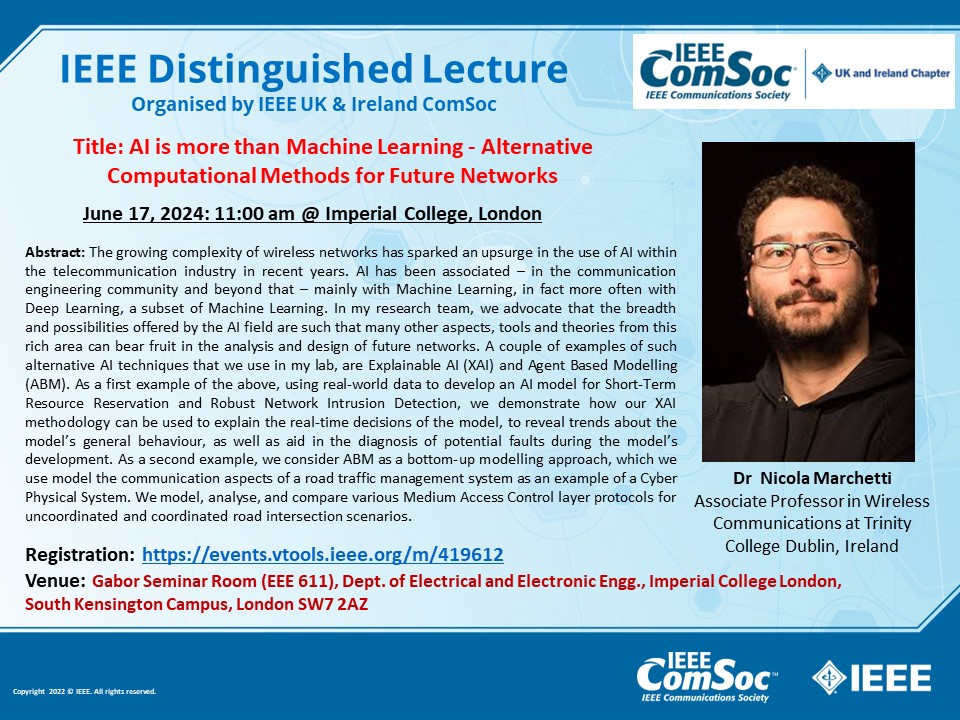IEEE UK and Ireland ComSoc Distinguished Lecture @ Imperial College
Date and Time
Location
Hosts
Registration
-
 Add Event to Calendar
Add Event to Calendar
- Dept. of Electrical and Electronic Engg., Imperial College London
- South Kensington Campus,
- London , England
- United Kingdom SW7 2AZ
- Building: Gabor Seminar Room (EEE 611)
- Room Number: EEE 611
- Contact Event Host
-
Nauman Aslam (nauman.aslam@northumbria.ac.uk)
Sundar Aditya (s.aditya@imperial.ac.uk)
- Co-sponsored by Imperial College London, UK
Speakers
Nicola of Trinity College Dublin, Republic of Ireland
AI is more than Machine Learning - Alternative Computational Methods for Future Networks
The growing complexity of wireless networks has sparked an upsurge in the use of AI within the telecommunication industry in recent years. AI has been associated – in the communication engineering community and beyond that – mainly with Machine Learning, in fact more often with Deep Learning, a subset of Machine Learning. In my research team, we advocate that the breadth and possibilities offered by the AI field are such that many other aspects, tools and theories from this rich area can bear fruit in the analysis and design of future networks. A couple of examples of such alternative AI techniques that we use in my lab, are Explainable AI (XAI) and Agent Based Modelling (ABM). As a first example of the above, using real-world data to develop an AI model for Short-Term Resource Reservation and Robust Network Intrusion Detection, we demonstrate how our XAI methodology can be used to explain the real-time decisions of the model, to reveal trends about the model’s general behaviour, as well as aid in the diagnosis of potential faults during the model’s development. As a second example, we consider ABM as a bottom-up modelling approach, which we use model the communication aspects of a road traffic management system as an example of a Cyber Physical System. We model, analyse, and compare various Medium Access Control layer protocols for uncoordinated and coordinated road intersection scenarios.
Biography:
Dr. Nicola Marchetti is Associate Professor in Wireless Communications at Trinity College Dublin, Republic of Ireland, where he leads the Wireless Engineering and Complexity Science lab (WhyCOM). He is an IEEE Communications Society Distinguished Lecturer, an IEEE Senior Member, and a Fellow of Trinity College Dublin. He received the PhD in Wireless Communications from Aalborg University, Denmark in 2007, the MSc in Electronic Engineering from University of Ferrara, Italy in 2003, and the MSc in Mathematics from Aalborg University in 2010. He has authored more than 190 journals and conference papers, 2 books and 9 book chapters, holds 4 patents, and received 4 best paper awards. His research interests span AI for Future Networks, Bio-Inspired and Bio-Enabled Networks, Complex and Autonomous Networks, MAC Protocols and Radio Resource Management, Signal Processing for Communications, and Quantum Communications and Networks. He serves as Technical Editor for IEEE Network and IEEE Wireless Communications, and has served as an Associate Editor for the IEEE Internet of Things Journal and the EURASIP Journal on Wireless Communications and Networking.


